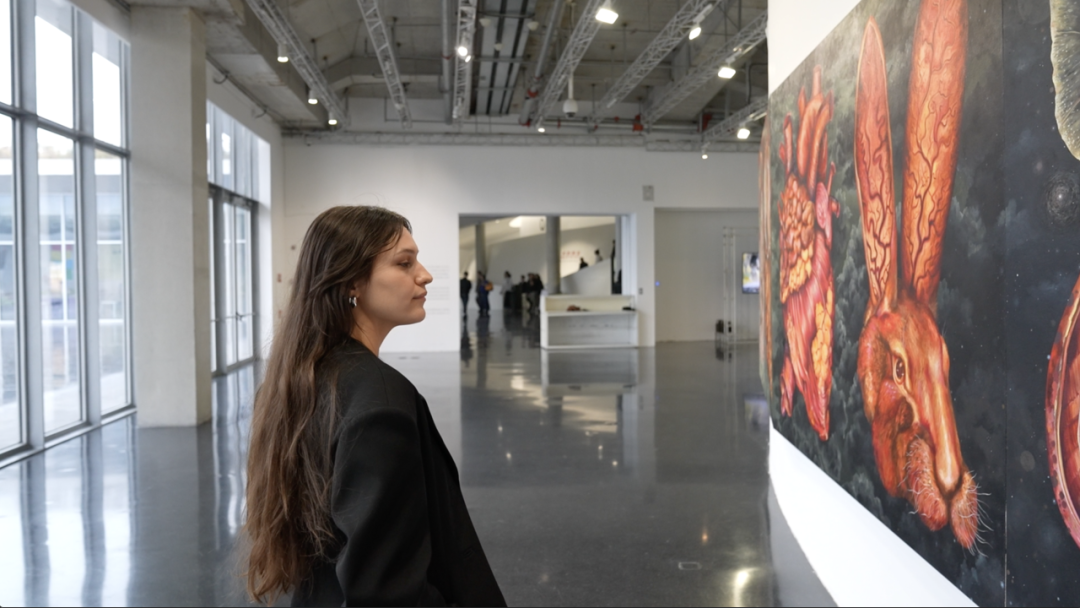
(8).jpeg)
Installation view of the exhibition “CYCLES”
摄影:JJYPHOTO
“CYCLES” was originally conceived as a continuous narrative painting, due to practical reasons, is broken up into six individual paintings, each of which is coupled with two subjects. The initial premise of the show is really about working from associations with animals.
Kat Lyons: When I was originally planning, I didn't have a strong idea of how the process would unfold, who would be paired together, and what 12 subjects I would be using. I think it's interesting that it all started with a crab. A crab feels like a very primordial being. They inhabit landscapes that are both aquatic and terrestrial. In many ways, they seem to live beyond time, and time is a significant element present in these paintings.
In many ways, they give the impression of living beyond time, and time is a significant character present in these paintings. As for the human construction of a 24-hour cycle, it’s something I’m considering.
When I originally planned this work, there were no concrete ideas or formulations. Everything you see on the canvas was created without any preparatory drawings, making them immediate and spontaneous. I draw inspiration from cultural representations of animals and am interested in collecting imagery to store in my internal archive. I believe that the process of painting can reveal the character of a subject or how the individual artist perceives it. This was truly at the heart of this work, without drawing from any direct reference or influence.
In the relationships between the subjects, some intriguing connections emerge. For instance, consider the relationship between the crocodile and the bird. Birds are essentially reptilian, and crocodiles also lay eggs. This is an easy correlation to make, but something interesting happens when you’re painting. The scales of the crocodile influenced how I painted. I found myself responding to those scales. It’s almost as if there’s an armature, a kind of armor to the way I painted the birds. They almost seem like scales themselves. This progression led me to observe the texture of the eggs, which helped me think about the beautiful textures of wild fruits and their variations. I have a friend who studies wild apples, and I was looking at images of those paintings and found myself completely captivated.
I wanted the paint to convey the rich texture and variety of the grapes, something that seems a bit less present in the sterilized fruit that we consume. As you progress through the painting, I hope it suggests the fluctuating forces of life that connect them. You’re guided through phases of death and vitality. There is a narrative that unfolds, intentionally or not, when you’re painting, and I hope that’s present in this work.
I also found myself contemplating what painting brings you to. I ended up having a lot of internal dialogue about the concept of territory, specifically ecological territory. As someone interested in post-natural studies, I often think about how humans demarcate territory and lines, and how landscape is often used as a tool for human knowledge. While not necessarily negative, it does create certain relationships that we rely upon when it comes to how we relate to the natural world.
I conceived of these paintings as something that hopefully feels more like a constellation of identities, rather than hierarchical. Everything could exist in a unified size, a unified type of attention.
There are also questions about the scale of the micro and the macro, where the large and the small are given equal attention. This is important as a suggestion that all life is of similar importance, and to highlight the complexity of life forms and their essential role in the scheme of life.
The idea of landscape territory invites questions about which animals belong where, which is an ever complex question and conversation, especially considering globalization and our ideas of what it means to conserve a place. Do we consider the migratory birds that pass through a place every year, but only for a couple hours? Are they part of that ecosystem?
This work really tries to highlight the global scale of the world and all of its participants, while also emphasizing the intimate nature of life and individuality itself.

